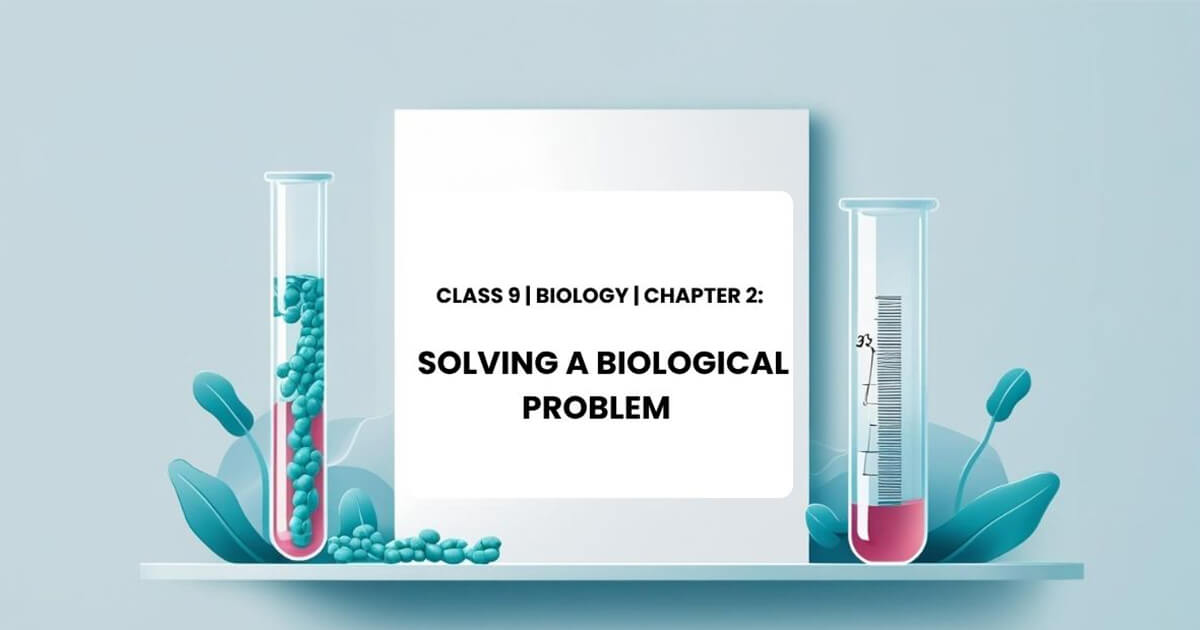Class 9 Biology Chapter 2 MCQs introduces students to the process of scientific investigation. This post help students test their understanding of how biologists identify and solve problems through observations, data collection, experimentation, and drawing conclusions. These MCQs cover concepts such as hypothesis formation, variable types, scientific method steps, and data interpretation.
1. What is the first step in solving a biological problem?
- A. Drawing a conclusion
- B. Data analysis
- C. Observation ✅
- D. Forming a hypothesis
Explanation: The scientific process begins with making observations that lead to identifying a biological problem.
2. Which one of these is an example of qualitative observation?
- A. Leaf is 5 cm long
- B. Leaf is green ✅
- C. Temperature is 37°C
- D. Plant is 10 cm tall
Explanation: Qualitative observations describe qualities — like color, shape, or texture — without using numbers.
3. What is a hypothesis?
- A. A proposed explanation for an observation ✅
- B. Final conclusion of an experiment
- C. A biological law
- D. A measurement tool
Explanation: A hypothesis is a testable statement or prediction based on initial observations.
4. In an experiment, the variable that is changed is known as:
- A. Dependent variable
- B. Independent variable ✅
- C. Controlled variable
- D. Random variable
Explanation: The independent variable is the one that is intentionally changed to test its effect.
5. Which of the following best describes data analysis?
- A. Forming a hypothesis
- B. Drawing conclusions
- C. Organizing and interpreting collected data ✅
- D. Asking a question
Explanation: Data analysis involves sorting, organizing, and making sense of experimental data to understand results.
6. What makes a hypothesis scientific?
- A. It must be popular
- B. It must be accepted by all scientists
- C. It must be testable ✅
- D. It must be correct
Explanation: A hypothesis is only scientific if it can be tested through observation or experimentation.
7. Which step comes immediately after forming a hypothesis?
- A. Observation
- B. Data collection
- C. Deduction ✅
- D. Conclusion
Explanation: After a hypothesis, deductions are made to design experiments that test the prediction.
8. In a controlled experiment, what is held constant?
- A. Controlled variables ✅
- B. Dependent variable
- C. Independent variable
- D. Data
Explanation: Controlled variables remain unchanged to ensure that results are due to the independent variable only.
9. What is the role of deduction in the scientific method?
- A. Drawing diagrams
- B. Predicting results from a hypothesis ✅
- C. Observing results
- D. Reviewing literature
Explanation: Deduction involves logical predictions that are tested through experiments.
10. Which of the following represents quantitative data?
- A. The flower smells sweet
- B. The leaf is 6 cm long ✅
- C. The soil is moist
- D. The frog is green
Explanation: Quantitative data involves numerical values, like length, weight, or temperature.
11. Which part of a scientific investigation involves graphs or tables?
- A. Hypothesis
- B. Observation
- C. Data analysis ✅
- D. Experimentation
Explanation: During data analysis, results are often presented in visual formats for easier interpretation.
12. Why is repetition important in scientific experiments?
- A. It saves time
- B. It increases reliability ✅
- C. It makes experiments shorter
- D. It makes results perfect
Explanation: Repeating experiments helps verify results and ensures accuracy.
13. What is an inference?
- A. A question
- B. A tool
- C. A logical conclusion based on observations ✅
- D. An assumption
Explanation: Inference is a reasoned interpretation drawn from observations or data.
14. Which statement about the malaria investigation is correct?
- A. Scientists guessed it was bacteria
- B. They avoided using the scientific method
- C. They observed patterns before testing hypotheses ✅
- D. It involved chemistry only
Explanation: Observations of patient conditions and mosquito populations led to hypothesis testing.
15. What is the last step in solving a biological problem?
- A. Hypothesis
- B. Deduction
- C. Reporting results ✅
- D. Observation
Explanation: After drawing conclusions, scientists share findings through reports and publications.

